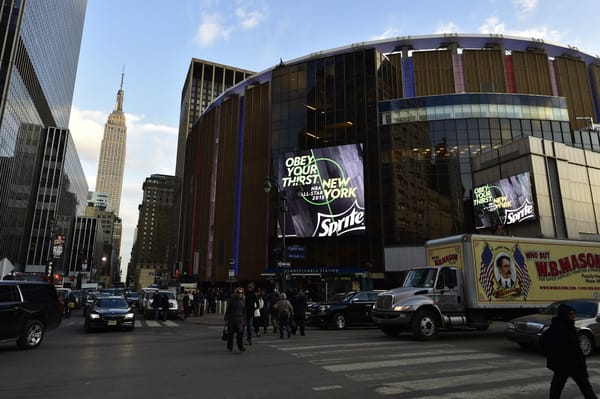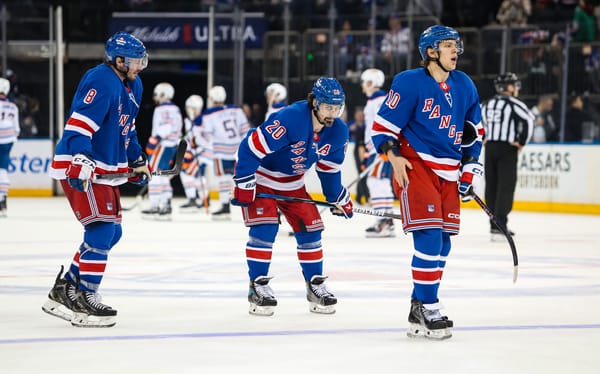What Have We Learned: A Look at Games 43-50
We are 50 games into the season and the New York Rangers have a 25-20-5 record (55 points) and are just one point out of the second wild card spot. It’s at the point in the season when teams have to evaluate their progress and determine whether they’re strong enough to compete for the Stanley Cup.
These last eight games should have given the Rangers some direction in their assessment, although whether or not the team is honest about who they are is a different story for a different day.
We last left off with the Rangers losing to the Vegas Golden Knights before their bye week, in a game that probably should have been a blow out, but was kept within reach by Ondrej Pavelec.
We return with the Blueshirts’ first game back from the bye week, a tilt against the New York Islanders. It was thought that Kevin Hayes would remain out with injury, after sustaining a lower-body injury in Vegas, but he was surprisingly healthy enough to dress (although, his injury was either re-aggravated or lingered long enough to keep him out until January 25 after this game). Pavelec started this one, but after five goals got past him, Lundqvist took over – and he didn’t look too pleased with his team… or coaches.
Most games against the Islanders are high-pressure matchups, but the Rangers just didn’t rise to the occasion or act as a collective unit, and the players let their frustrations be heard. The lineup was less than ideal (second-liner Jesper Fast, third liner-Pavel Buchnevich, and fourth-liner Jimmy Vesey stuck out on offense, while on defense Steven Kampfer was in for Brendan Smith) and Lundqvist didn’t get to rest like the team could have hoped.
But the Rangers had to find a way to build off this loss – and quickly, because they were back in action the next day in Pittsburgh. Lundqvist was in net, Smith returned to the lineup, and some of the forward lines were tweaked. Despite a first period lead, thanks to Michael Grabner and Smith scoring, they fell apart in the second period and never regained their game.
The Rangers returned home hoping to end their three game skid in their first meeting of the season with the Philadelphia Flyers, and the team finally look inspired. The Rangers’ offense exploded with five goals, and the 5-1 win was their first regulation win since January 19 and one of the best of the season. Coincidentally, this iteration of the lineup was actually somewhat balanced too; Peter Holland was recalled to center Grabner and Fast, while Buchnevich moved up to the first line alongside Mika Zibanejad and Rick Nash.
Nash scored two goals, Grabner added another, Carey scored the Rangers’ first short-handed goal of the year, and the defense actually gave Lundqvist support.
As much as this win should have instilled some confidence, because at least it showed the Rangers are capable of a complete effort, they couldn’t maintain it in the following game – not even against the team that’s second-to-last in the league standings.
The plus from the 4-3 victory was that Nash had another two-goal night; the minus was that the Rangers struggled to maintain their leads against the Buffalo Sabres for the second time in a month. It wasn’t exactly an encouraging win, especially when it was their last home game before a road trip into the Western Conference. The game should have never been as close as it was, but the team picked up two points.
The first game of the Rangers’ road trip was against one of the hottest teams in the league, the Colorado Avalanche, and they were without Hayes, Grabner, Shattenkirk, and Staal. DeAngelo was recalled to compensate from the offense lost on the blue line.
With a depleted lineup, a challenging matchup and less than ideal recent away record, it’s not that losing seemed inevitable… but it didn’t seem like they were bound to land in the win column either – and they didn’t. But that’s not an excuse, especially when the Rangers’ playoff hopes are in doubt.
It may have only been a 3-1 loss, and that third goal was scored on an empty net, but Lundqvist masked the Rangers’ deficiencies. The Avalanche took 60.75 percent of the 5-on-5 shot attempts, had 58.14 percent of the scoring chances, and 62.5 percent of the high-danger shot attempts. Sixty-five 5-on-5 shot attempts were sent Lundqvist’s way, with 36 reaching the goal; only 42 shot attempts were generated by the Rangers and 20 of those didn’t go on net.
The next night, they were back in action against the Los Angeles Kings. While the Rangers pulled ahead 2-0 early in the game, they started collapsing towards the end of the first period and completely fell apart in the second period. The Kings scored three consecutive power-play goals in the second period, and added another goal early in the third period.
Before this matchup, the Rangers’ penalty kill on the surface seemed to be effective, and ranked highly in the league. It’s down to 81.6 efficiency now, which ranks 15th in the league.
While on the penalty kill, according to Corsica, the Rangers allow the lowest rate of shot attempts against in the league (92.34 per hour). However, the shots that are taken are usually high quality chances (7.67 expected goals against per hour), and they paid for that in Los Angeles. It completely deflated them and resulted in another loss added to their record.
For their third game of the road trip, the Rangers faced off against the Ducks. While the Rangers weren’t anemic on defense for a change, their transitional game was what cost them, and unfortunately Lundqvist wasn’t having a great night, so he was subsequently pulled. A J.T. Miller turnover at the end of the first period prematurely ended his night as well; he didn’t see a single shift for the remainder of the period, nor did he step on the ice in the second or third period.
As much as Miller should have been held accountable for his mistake, pulling him from the next 40 minutes of a game was drastic, especially when the team craved offense that he could provide. There has to be a balance between discipline and what’s best for the team; benching Miller for 40 minutes was more than just discipline and wasn’t in the best interest of the team.
For their fourth, and luckily final, game of this road trip, the Rangers were in San Jose. Lundqvist got the night off, and Hayes returned to the lineup to skate alongside Miller and Zuccarello. The highlights included Hayes and Miller each adding a goal and an assist, plus Zuccarello tallying an assist. McDonagh finally scored his first goal of the season, and added a second one on the power play. But the Rangers still allowed five goals, including one that was scored in the final moments to make it a one-goal game.
So what have we learned?
Over this span of eight games, Nash has had three two-goal games and accumulated eight points. This brings him up to 25 points in 50 games, (19 5-on-5 points, which ranks third on team), and while 25 points in 50 games isn’t exactly ideal, his recent scoring burst is a step in the right direction.
His scoring has increased since being put on a line with Zibanejad and Buchnevich. Oddly enough, Buchnevich and Nash had scarcely played together this season. Buchnevich belongs in the top-six and has been helping Nash rediscover his scoring touch with his stellar passing, and both of these wingers compliment Zibanejad as well. Nash’s game is similar to Kreider, between his speed, strength, and net-front presence, so it makes sense that this combination works – it’s just puzzling why it wasn’t tried sooner, since Nash wasn’t scoring and keeping Buchnevich in the bottom-six was a waste of his talents.
Despite being on the ice for 4.87 goals for per 60, their expected goals for per 60 is only 2.94, so there’s definitely a chance that their production slows. Until that happens (and if it happens), this line should stay together because they’ve been a reliable source of offense that this team was in need of.
This team needed that offensive boost especially over these last games because of player injuries. Hayes sustained a lower body injury in Vegas, wasn’t expected to play against the Islanders after their bye week, but ultimately dressed. But after that game, he didn’t return to the lineup until seven games later when they played the Sharks. So, the question stands, was Hayes actually ready to return when he did, or did his premature return re-aggravate the injury?
That wasn’t the only debatable injury management we learned about. It was announced that Shattenkirk had a tear in his meniscus and would be out indefinitely. On a team level, being without Shattenkirk only diminishes their chances moving forward. But there’s another issue with this injury – that he was allowed to play through it. Most players insist on playing despite their injuries, which is why that decision can’t be left solely with them.
Shattenkirk said he's been dealing with the knee injury since late September and into October. He said he tried to play through it but felt he's "come to a point now ... [that] it's the right time to get the surgery." #NYR
— New York Rangers (@NYRangers) January 19, 2018
Trainers and doctors are supposed to advocate for what’s best for the player; it’s questionable if playing through a meniscus tear is what’s best for a player’s long-term health. In this case, it prolonged the inevitable and could have made the injury worse, and now the Rangers are without Shattenkirk in one of the most critical parts of the season.
Without Shattenkirk in the lineup, DeAngelo has a second opportunity with the Rangers at the NHL level. Through four games, he has two assists – one even strength, and one power play. While there’s obviously still work to be done in his own zone, he’s shown glimpses of that offensive upside that enticed the Rangers enough to acquire him in the first place. The hope though, is that he genuinely gets an opportunity to develop at the NHL level even if he makes mistakes, so the Rangers can assess whether he can be a key piece of this team moving forward or not.
So over the last eight games, it became even more clear (in case it wasn’t already) that this team needs to tighten up defensively to support their goaltenders. And they also need to improve play in the offensive zone to boost their production, especially without Shattenkirk on the blue line. Additionally the Rangers need to improve their penalty killing, something that outright cost them their game against the Kings.
In reaction, the Rangers claimed Cody McLeod off of waivers. In 713 career NHL games, he has 124 points… and 1,524 penalty minutes. They need scoring depth, could use more right-handed shots, shouldn’t be taking penalties, and should be giving their young players a longer look at the NHL level if they’re rebuilding. Instead, they found a 33-year-old left-handed grinder, who collects penalty minutes, and doesn’t score much. And he’s likely going to take away an opportunity from one of the team’s younger players. It just doesn’t add up, nor does it fit the Rangers’ needs. Then again, neither did Tanner Glass, and he had a place in the lineup even when they were desperate for offense.
This move is a step backwards and Alain Vigneault’s probably going to use him over more skilled options, and he’s at fault for that. Jeff Gorton is just as much at fault for not just allowing another situation like this, but for bringing this type of player into their roster rather than actually assessing their needs. He initiated a rebuild on the fly, but hasn’t done nearly enough throughout the season to remedy the Rangers’ shortcomings, and this is another prime example of that.
The Rangers have only collected three wins in their last eight, and six out of a possible 16 points. Only one win on a four game road trip isn’t encouraging, and doesn’t bode well for a team contemplating how to proceed at the deadline. This roster is clearly flawed, especially with Shattenkirk and Kreider’s injuries in mind, but it’s much more than just the roster. This roster still isn’t being led in the right direction and the fact that both coach and general manager believe that McLeod brings an element that the Rangers needed after this last string of games is just concerning.
It has to be questioned though, that if the Rangers had lost all four of their road games before the break, would it have swayed management to make changes behind the bench? It’s been a mediocre season plagued by poor coaching, so would that have been the final straw?
In one of the Rangers last eight games, they put forward a complete effort and were led in the right direction. In seven, there were lineup issues, deployment issues, tactical issues, special team issues, and more that stunted their potential and cost them points in five games.
The drastic changes made this past offseason were supposed to help the Rangers go further into the playoffs, but not only were they not executed as well as they could have been, but the coaches still don’t seem to be on the same page. The Rangers haven’t and are unlikely to reach their potential this season – instead, their mediocrity has only lowered their potential, despite strong goaltending.
The Rangers yet again look destined for the middle – and these last eight games only emphasize that – so changes are clearly necessary. But what’s becoming more questionable as this season progresses is whether it’s counterproductive to rebuild with this coaching staff and if this front office is the best to handle a rebuild on the fly.
The last eight games indicate otherwise.




